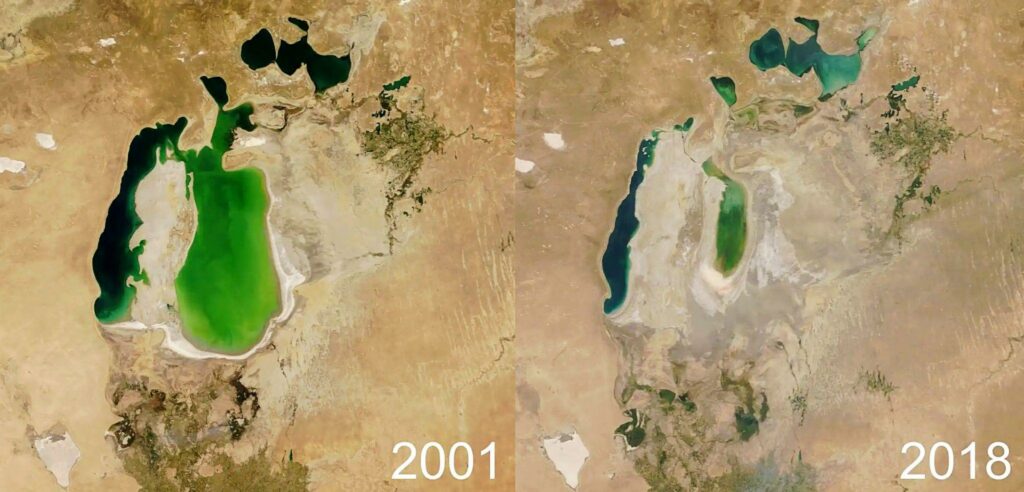Why UN Experts Say Focus Should Be on the Health-Environment Nexus
On January 30, 2020, COVID-19 was declared a Public Health Emergency of International Concern (PHEIC). As of January 25, 2023, it has killed more than 6.7 million people, as reported by the World Health Organization (WHO). Classified as a zoonotic disease — like 75% of all newly discovered global diseases — COVID jumped from non-human animals to humans, driven by man-made environmental impacts.
But unfortunately, the pandemic is just one reminder of the consequences of a much bigger problem. UN experts say the days of confronting environmental and health issues through different policies and programs are over, and the fight against climate change has evolved.
In this report, we talk to Sangmin Nam, Director of the Environment and Development Division, and Sanjay Srivastava, Chief of Disaster Risk Reduction of the United Nations Economic and Social Commission for Asia and the Pacific (UNESCAP). These experts uncover new challenges, technology uses, nature-based solutions, and projects making a real impact on the ground.
“What we are seeing is that the environmental, health, and climate change risks are increasingly converging, meaning that they cannot be tackled independently from each other,” Nam said.
Sustainable economic growth: Adding the “H” to ESG

Photo Unsplash/Lê Tân.
Over the past years, regions like Asia and the Pacific have made significant progress in lifting billions of people out of poverty. However, economic growth has been based on unsustainable development models. The region accounts for more than half of global greenhouse gas emissions and two-thirds of premature death due to air pollution, UNESCAP data shows. Additionally, a quarter of endemic species in the region face a high risk of extinction.
By 2023, environmental, social, and governance (ESG) reports will be disclosed by all leading companies around the world, becoming a must-have component for business. In early 2022, Bloomberg reported that global ESG assets could surpass the $41 trillion mark by 2020, reaching $50 trillion by 2025. But the increasing wave of ESG investments may be based on outdated approaches.
While organizations swiftly — and without doubts — invest in ESG programs and assets, health is often left behind. Experts have advocated adding the “H” for health to ESG. Broadening the standards to ESHG, and including solid components for the health-environment nexus should be a movement led by governments and the private sector.
Partnerships with the private sector are critical for UNESCAP in making a difference in the region. Enterprise diversity is also leveraged as each partner has unique strengths and resources.
“Ultimately, what we are facing is not only environmental or health challenges but also political-economic challenges,” Nam said. “There is an urgent need for the political leadership of all sectors — whether it is the environment, health, finance, agriculture, among others — to come to gather to deliver joint agendas which can not only reduce the risks we are facing, but will also deliver co-benefits for human well-being in a much more cost-effective way.”
“We need an integrated environment-health nexus approach or a One Health approach to manage these interlinkages,” Nam added.
Nature-based solutions in the most disaster-prone region
The relationship between health and the environment in Asia and the Pacific is strongly felt. The region is the most disaster-prone in the world and faces a continuing decline in biodiversity and ecosystem services.
“It has been predicted that the next global pandemic is likely to arise again from the region, largely due to its multiple risk factors, including environmental degradation and habitat destruction, (coexisting) large and concentrated human and livestock populations, high levels of urbanization, extensive trade and consumption of wildlife, among others,” Nam explained.
This unique set of factors urgently presses Asia and the Pacific to address the linked environment-health risks. “While environmental degradation presents one of the root causes of the problem, nature also provides some of the solutions,” Nam adds, introducing the concept of nature-based solutions.
Nature-based solutions are those that protect, sustainably manage, and restore ecosystems. Climate change and food and water security impacts can be mitigated by taking action on these three pillars while enhancing biodiversity. These channels will consequently improve human health while contributing to sustainable livelihoods and economic development. “Nature-based solutions provide critical opportunities to mitigate health risks and deliver co-benefits for nature and human health,” Nam explained.
Examples of nature-based solutions include the strategic application of diverse species, such as trees in urban areas that contribute to cooler cities and cleaner air; the restoration of mangroves in coastal areas reducing coastal flood risk; or the specific ecosystem services such as clean water projects which will impact hygiene and sanitation and human health.
Pakistan’s Ten Billion Trees and the Indian Village of Piplantri

Trees dot the landscape at Panjpeer Rocks, Pakistan. Photo: Shakeel Ahmad/Unsplash.
Nam cites Pakistan’s Ten Billion Trees Tsunami campaign as a real-world example of a nature-based project that can impact human health by restoring the environment. Pakistan’s long history of deforestation has slashed remaining forests to just 2% of total coverage. Without forests, the people of Pakistan are left vulnerable to the full impact of intensifying monsoon rains and increasing floods, hotter temperatures, and melting Himalayan glaciers.
“The Ten Billion Trees Tsunami campaign…is a great example of nature-based solutions (planting trees) contributing to climate mitigation and adaptation, supporting the revival of forest and wildlife resources, engaging communities and providing multiple green jobs,” Nam said.
Engagement with local communities is also proven to be essential. In the Piplantri village, in the Indian state of Rajasthan, local communities have established an impactful initiative to protect the ecosystem, build social capital, and shift harmful gender bias. “Every time a baby girl is born, the village celebrates by planting 111 trees and depositing money into an account for her,” Nam revealed.
Data-driven public portals, science, and technology

UNESCAP Aral Sea basin depleting over the years.
UNESCAP turns to science, data, and technology to facilitate and support programs that aim to mitigate and prevent complex, compounding, and cascading risks. Srivastava, head of Disaster Risk Reduction, introduced the Risk and Resilience Portal as a “one-stop shop.”
The main goal of the portal is to ensure that the vast array of scientific information on hazards, climate change, and social, economic, and health data can be analyzed in a way that countries can use to monitor climate and disaster-related Sustainable Development Goals (SDG). It is also designed to build efficient risk-informed decisions across multiple sectors.
The portal provides data visualizations, analytics, and maps of risk hotspots of complex dangers, such as the overlaps between climate-related natural and biological hazards. The portal also includes vulnerability information such as population and infrastructure exposure under multiple climate risk scenarios and transboundary threats with the interplay of climate change, increasing disasters, and socioeconomic factors that multiply risks, such as in the Aral Sea.
Finally, Srivastava highlights the data the portal provides on climate risk profiles (historical and future scenarios) and adaptation priorities of 55 countries, as well as decision support systems for risk-informed policy decisions in five countries.
“The Portal knowledge products have helped strengthen sub-regional cooperation efforts with a successful example for the Aral Sea Catastrophe,” Srivastava said. “Using state-of-art visualization narrative, the Portal created an easy-to-understand storyboard on the Aral Sea for policymakers, aggregating historical and projected climate data and the impacts on the Aral Sea under one platform. The storyboard provides interactive maps, charts, and data that have been used by policymakers in multiple ways.”
Additionally, the Risk and Resilience Portal’s analytics on climate risks and customized adaptation policies are now mainstreamed in Bhutan’s 2022 Country Common Analysis Framework. In Pakistan, the prototype of the Pakistan Decision Support System was used to inform the first consultation of the country’s new National Adaptation Process.
COP15 Landmark Agreement Opens New Opportunities
However, it’s not just APAC countries that understand the importance of taking a new approach to the environment. In late December 2022, the United Nations COP15 ended with a landmark agreement.
Nam said that the major takeaway from the summit was the adoption of the Kunming-Montreal Global Biodiversity Framework (GBF), which includes 23 measurable targets supported by monitoring and financing plans.
The plans will work to ensure 30% of our ocean and land are protected areas by 2030. Additionally, it sets out to restore 30% of degraded ecosystems and provide $30 billion annually in biodiversity-related funding for developing countries by 2030.
“The 30 % goals will be significant for supporting nature-based solutions that are being widely promoted at national and international levels,” Nam said. However, the health-environment nexus was once again overshadowed by pressing issues and gone amiss.
“One of the points that was left out of the framework is the adequate integration of biodiversity-health links into the targets, despite extensive discussions during COP15 and associated events,” Nam said.
Despite the gaps, opportunities are expected. Countries will now have to update their National Biodiversity Strategies and Action Plans (NBSAPs) to reflect the new decisions. “This offers an opportunity to include the linkages between health and the environment more explicitly,” Nam concluded.
While global efforts to combat climate change and create a more fair, resilient, and stronger society cannot be denied, new challenges emerge as we move forward. The interconnected link between human health and the environment is the only way to solve the problems at their root cause, instead of continually fighting the symptoms. The road ahead requires multiple-approach cross-level cooperation and coordination, a shift in perceptions, and the collaboration of science and technology and the public and private sector.
Featured image by UNESCAP




